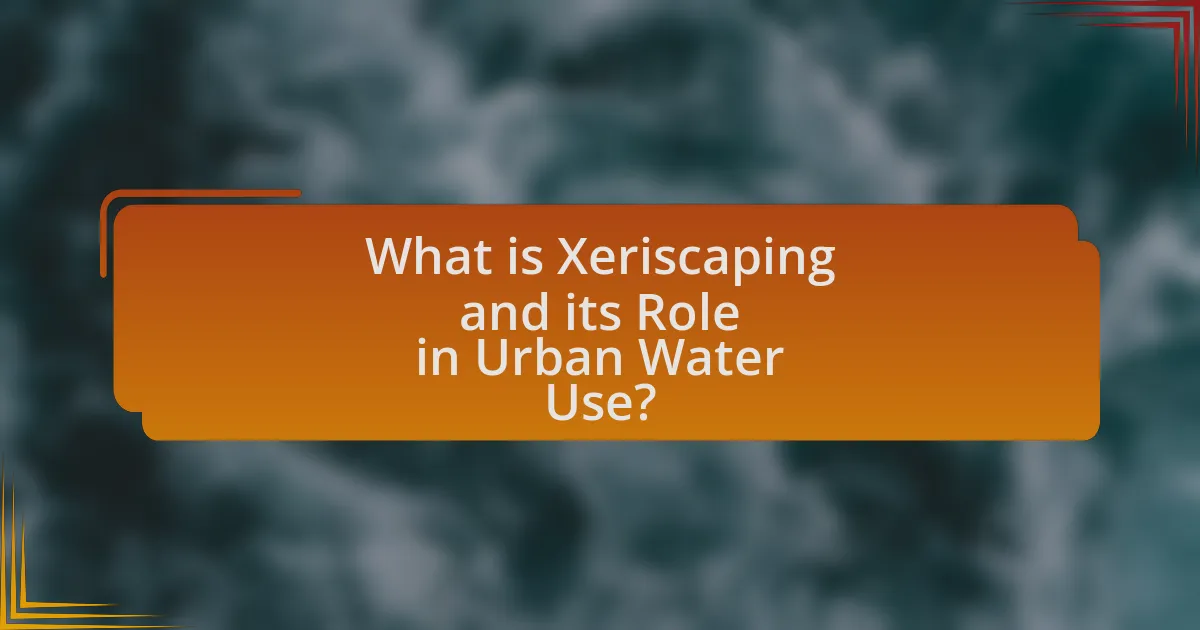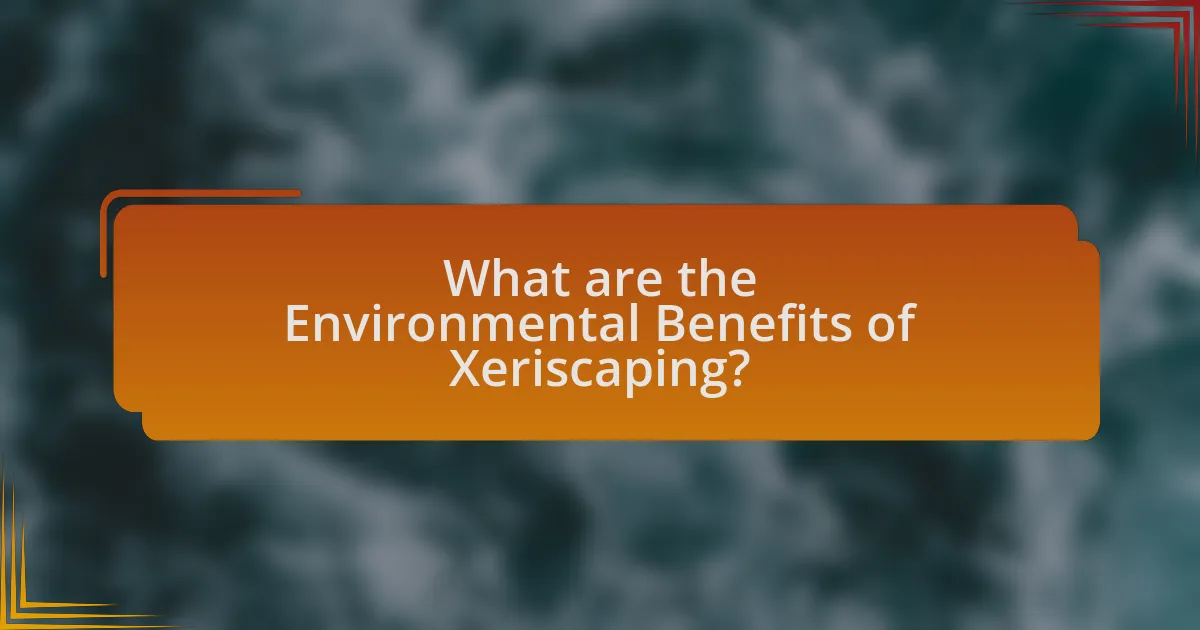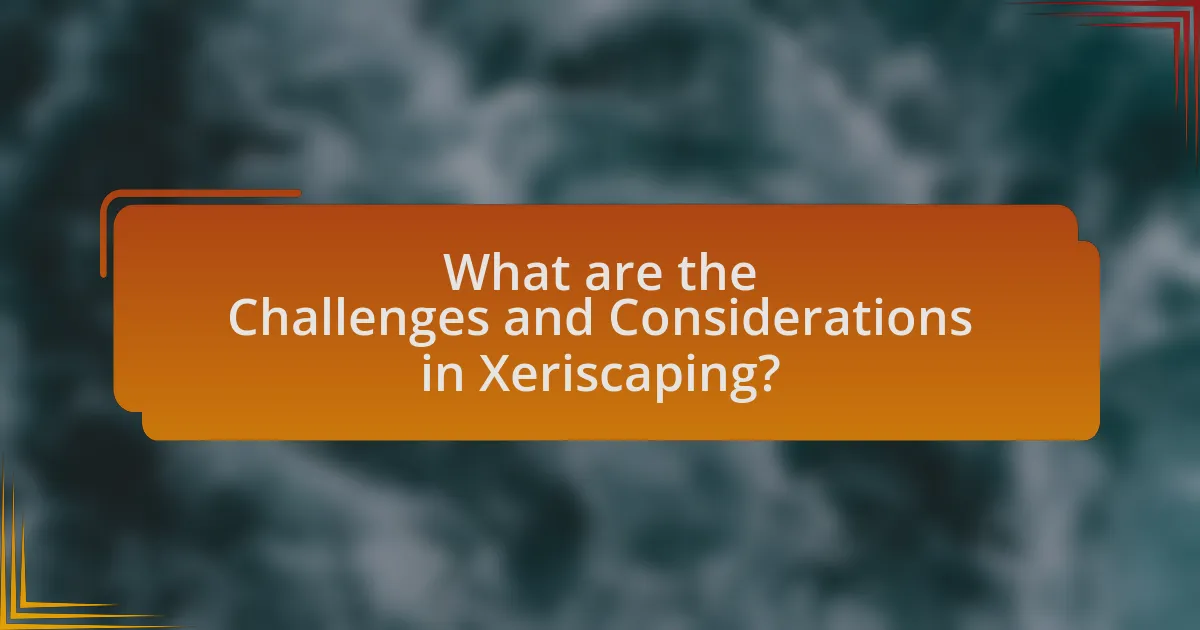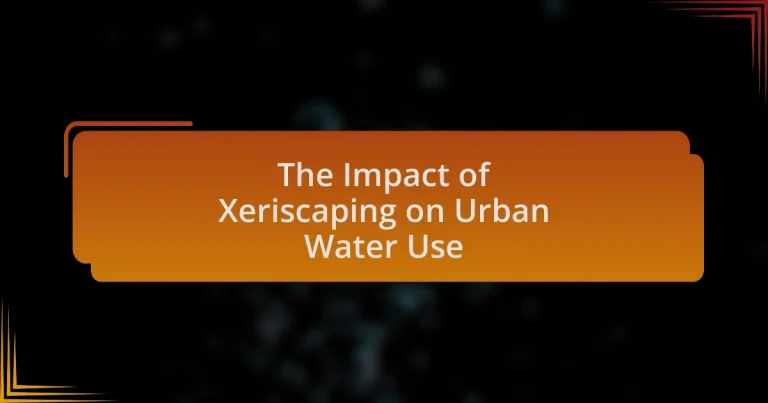Xeriscaping is a landscaping method aimed at reducing or eliminating the need for irrigation through the use of drought-resistant plants and efficient water management techniques. This approach is particularly significant in urban environments, where it can decrease water consumption by 50% to 75%, alleviating pressure on municipal water supplies and promoting sustainable practices. The article explores the differences between xeriscaping and traditional landscaping, outlines its key principles, and discusses its environmental and economic benefits. Additionally, it addresses challenges and misconceptions associated with xeriscaping, providing practical tips for homeowners and strategies for urban planners to effectively integrate this method into community landscapes.
What is Xeriscaping and its Role in Urban Water Use?

Xeriscaping is a landscaping method designed to reduce or eliminate the need for irrigation by using drought-resistant plants and efficient water management techniques. This approach plays a significant role in urban water use by significantly decreasing water consumption, which is crucial in areas facing water scarcity. Studies indicate that xeriscaping can reduce landscape water use by 50% to 75% compared to traditional landscaping methods, thereby alleviating pressure on municipal water supplies and promoting sustainable water practices in urban environments.
How does Xeriscaping differ from traditional landscaping?
Xeriscaping differs from traditional landscaping primarily in its focus on water conservation. While traditional landscaping often relies on high water usage for maintaining lush, green lawns and diverse plant species, xeriscaping emphasizes the use of drought-resistant plants and efficient irrigation techniques to minimize water consumption. Xeriscaping can reduce outdoor water use by up to 50% or more, as it incorporates native plants that are adapted to local climate conditions, thus requiring less maintenance and irrigation compared to non-native species commonly used in traditional landscaping.
What are the key principles of Xeriscaping?
The key principles of Xeriscaping include planning and design, soil improvement, efficient irrigation, plant selection, mulching, and maintenance. Planning and design involve creating a landscape that minimizes water use while maximizing aesthetic appeal. Soil improvement focuses on enhancing soil quality to retain moisture and support plant health. Efficient irrigation techniques, such as drip systems, reduce water waste. Plant selection emphasizes drought-resistant species that require less water. Mulching helps retain soil moisture and suppress weeds. Finally, regular maintenance ensures the landscape remains healthy and efficient in water use. These principles collectively contribute to significant reductions in urban water consumption, promoting sustainable landscaping practices.
How does Xeriscaping contribute to water conservation?
Xeriscaping contributes to water conservation by utilizing drought-resistant plants and efficient landscaping techniques that significantly reduce the need for irrigation. This method minimizes water usage by selecting native or adapted plants that thrive in local climates, thereby decreasing reliance on supplemental watering. Studies indicate that xeriscaped landscapes can use up to 50% less water compared to traditional lawns, leading to substantial savings in urban water consumption.
Why is Xeriscaping important for urban environments?
Xeriscaping is important for urban environments because it significantly reduces water consumption and promotes sustainable landscaping practices. In urban areas, where water resources are often limited and demand is high, implementing xeriscaping can lead to a reduction in landscape irrigation needs by up to 50-75%. This is particularly crucial in regions facing drought or water scarcity, as it helps conserve valuable water resources while maintaining green spaces. Additionally, xeriscaping utilizes drought-resistant plants that require minimal maintenance, which further decreases the need for chemical fertilizers and pesticides, promoting healthier ecosystems.
What challenges do urban areas face regarding water use?
Urban areas face significant challenges regarding water use, primarily due to increasing population density, infrastructure limitations, and climate variability. The growing population in cities leads to higher water demand, straining existing water supply systems. Additionally, aging infrastructure often results in water loss through leaks, further exacerbating the issue. Climate variability, including droughts and unpredictable rainfall patterns, complicates water management efforts, making it difficult for urban planners to ensure a reliable water supply. These factors collectively contribute to the challenges urban areas encounter in effectively managing water resources.
How can Xeriscaping mitigate urban water scarcity?
Xeriscaping can mitigate urban water scarcity by reducing the need for irrigation through the use of drought-resistant plants and efficient landscaping techniques. This approach conserves water by minimizing evaporation and runoff, allowing for sustainable water management in urban areas. Studies have shown that xeriscaped landscapes can use up to 50% less water compared to traditional lawns, significantly alleviating pressure on municipal water supplies during dry periods.
What are the Environmental Benefits of Xeriscaping?

Xeriscaping provides significant environmental benefits by reducing water consumption and promoting biodiversity. This landscaping method utilizes drought-resistant plants, which require less irrigation, thereby conserving water resources. Studies indicate that xeriscaping can reduce landscape water use by up to 50% compared to traditional landscaping methods. Additionally, xeriscaping supports local ecosystems by providing habitats for native wildlife, which enhances biodiversity. By minimizing the need for chemical fertilizers and pesticides, xeriscaping also contributes to improved soil health and water quality, reducing runoff pollution.
How does Xeriscaping impact local ecosystems?
Xeriscaping positively impacts local ecosystems by promoting biodiversity and reducing water consumption. This landscaping method utilizes drought-resistant plants, which can support native wildlife and pollinators, thereby enhancing local biodiversity. Additionally, xeriscaping minimizes the need for irrigation, leading to lower water usage and less strain on local water resources. Studies have shown that areas with xeriscaped landscapes can experience improved soil health and reduced runoff, which contributes to healthier ecosystems.
What native plants are commonly used in Xeriscaping?
Common native plants used in Xeriscaping include succulents, ornamental grasses, and drought-resistant shrubs. These plants are specifically chosen for their ability to thrive in arid conditions while minimizing water usage. For example, species such as Agave, Yucca, and various native grasses like Blue Grama are well-suited for Xeriscaping due to their low water requirements and adaptability to local climates. Research indicates that incorporating these native plants can significantly reduce urban water consumption, as they require less irrigation compared to non-native species.
How does Xeriscaping promote biodiversity?
Xeriscaping promotes biodiversity by creating habitats that support a variety of native plants and wildlife. This landscaping approach emphasizes the use of drought-resistant plants that are well-adapted to local climates, which in turn attracts diverse species of insects, birds, and other wildlife. Research indicates that areas designed with xeriscaping principles can increase the presence of pollinators and beneficial insects, contributing to a healthier ecosystem. For example, a study published in the journal “Ecological Applications” found that landscapes incorporating native plants can enhance species richness and abundance compared to traditional lawns.
What are the economic advantages of implementing Xeriscaping?
Implementing Xeriscaping offers significant economic advantages, primarily through reduced water costs and lower maintenance expenses. By utilizing drought-resistant plants and efficient irrigation techniques, Xeriscaping can decrease water consumption by up to 50% compared to traditional landscaping, leading to substantial savings on water bills. Additionally, the reduced need for fertilizers, pesticides, and frequent mowing lowers ongoing maintenance costs. A study by the University of Colorado found that homeowners who adopted Xeriscaping saved an average of $200 annually on water and maintenance expenses. These financial benefits make Xeriscaping an economically viable option for urban landscapes.
How does Xeriscaping reduce water bills for homeowners?
Xeriscaping reduces water bills for homeowners by significantly decreasing the amount of water required for landscape maintenance. This landscaping method utilizes drought-resistant plants and efficient irrigation techniques, which can lower outdoor water usage by up to 50% compared to traditional landscaping. Studies have shown that homeowners who implement xeriscaping can see a reduction in their water bills, as they rely less on municipal water supplies and more on natural rainfall.
What are the long-term cost savings associated with Xeriscaping?
Xeriscaping leads to significant long-term cost savings primarily through reduced water usage and lower maintenance expenses. By utilizing drought-resistant plants and efficient irrigation techniques, homeowners can decrease their water bills by up to 50% compared to traditional landscaping. Additionally, xeriscaped gardens typically require less frequent mowing, fertilizing, and pest control, which further lowers maintenance costs. Studies indicate that initial investments in xeriscaping can be recouped within a few years due to these ongoing savings, making it a financially advantageous choice for sustainable landscaping.
What are the Challenges and Considerations in Xeriscaping?

The challenges and considerations in xeriscaping include initial costs, plant selection, and maintenance requirements. Initial costs can be higher due to the need for specialized plants and landscaping materials that are drought-resistant. Proper plant selection is crucial, as choosing inappropriate species can lead to failure in establishing a sustainable landscape. Additionally, while xeriscaping reduces water usage, it still requires some maintenance, particularly in the establishment phase, to ensure plants thrive. These factors highlight the importance of careful planning and knowledge in implementing xeriscaping effectively.
What common misconceptions exist about Xeriscaping?
Common misconceptions about Xeriscaping include the belief that it results in a barren landscape and requires no maintenance. In reality, Xeriscaping promotes the use of drought-resistant plants that can create vibrant and diverse gardens while significantly reducing water usage. Additionally, while Xeriscaping minimizes water needs, it still requires some maintenance, such as pruning and occasional watering, especially during establishment. Studies show that properly designed Xeriscaped areas can reduce water consumption by up to 50% compared to traditional landscaping, demonstrating its effectiveness in urban water conservation.
How can these misconceptions be addressed?
Misconceptions about xeriscaping can be addressed through education and community engagement. Providing accurate information about xeriscaping’s benefits, such as reduced water usage and lower maintenance costs, can help dispel myths. Research indicates that xeriscaping can reduce landscape water use by up to 50%, as shown in studies conducted by the University of Colorado. Workshops, informational pamphlets, and local demonstrations can further illustrate successful xeriscaping practices, fostering a better understanding among residents.
What are the initial costs associated with Xeriscaping?
The initial costs associated with Xeriscaping typically range from $2 to $10 per square foot, depending on the complexity of the design and the materials used. This cost includes expenses for soil preparation, drought-resistant plants, mulch, and irrigation systems. For example, a 1,000 square foot Xeriscape project could cost between $2,000 and $10,000. Investing in Xeriscaping can lead to long-term savings on water bills, as it significantly reduces water usage compared to traditional landscaping.
How can urban planners effectively integrate Xeriscaping?
Urban planners can effectively integrate Xeriscaping by incorporating drought-resistant plants and efficient irrigation systems into landscape designs. This approach reduces water consumption significantly; studies show that Xeriscaping can decrease landscape water use by up to 50%. Additionally, urban planners should promote community education on the benefits of Xeriscaping, as informed residents are more likely to adopt these practices. Implementing local policies that incentivize Xeriscaping, such as tax breaks or grants for homeowners, can further enhance its adoption.
What strategies can be employed to promote Xeriscaping in communities?
To promote Xeriscaping in communities, strategies such as educational workshops, financial incentives, and community demonstration gardens can be employed. Educational workshops inform residents about the benefits of Xeriscaping, including reduced water usage and lower maintenance costs. Financial incentives, such as rebates for water-efficient landscaping, encourage homeowners to adopt Xeriscaping practices. Community demonstration gardens serve as practical examples, showcasing native plants and sustainable landscaping techniques, which can inspire residents to implement similar designs in their own yards. These strategies collectively enhance awareness and adoption of Xeriscaping, ultimately contributing to reduced urban water use.
How can policy changes support Xeriscaping initiatives?
Policy changes can support Xeriscaping initiatives by providing financial incentives, regulatory frameworks, and educational programs that promote water-efficient landscaping practices. For instance, municipalities can implement rebates for homeowners who convert traditional lawns to Xeriscaped gardens, thereby reducing water consumption. Additionally, zoning laws can be adjusted to allow for more native plant landscaping in public spaces, which has been shown to decrease irrigation needs by up to 50% compared to conventional landscaping. Furthermore, policies that mandate the use of drought-resistant plants in new developments can significantly lower urban water use, as evidenced by studies indicating that Xeriscaping can reduce landscape water use by 30-70%.
What practical tips can homeowners follow for successful Xeriscaping?
Homeowners can achieve successful Xeriscaping by implementing several practical tips. First, they should select drought-resistant plants that are well-suited to their local climate, as these plants require less water and maintenance. Additionally, homeowners should group plants with similar water needs together to optimize irrigation efficiency.
Incorporating mulch around plants helps retain soil moisture and reduce evaporation, which is crucial in arid environments. Homeowners should also design their landscapes to include efficient irrigation systems, such as drip irrigation, which delivers water directly to the plant roots, minimizing waste.
Finally, homeowners should regularly assess and adjust their watering schedules based on seasonal weather patterns to ensure that plants receive adequate moisture without overwatering. These strategies collectively contribute to reduced water usage, aligning with the goals of Xeriscaping and promoting sustainable urban water management.
How can homeowners select the right plants for Xeriscaping?
Homeowners can select the right plants for Xeriscaping by choosing native and drought-tolerant species that thrive in their local climate. These plants are adapted to require minimal water, making them ideal for reducing urban water use. For example, selecting plants such as succulents, ornamental grasses, and native wildflowers can significantly lower irrigation needs. Research indicates that native plants can use up to 50% less water compared to non-native species, thereby contributing to sustainable landscaping practices.
What maintenance practices are essential for Xeriscaped gardens?
Essential maintenance practices for Xeriscaped gardens include regular weeding, mulching, and monitoring irrigation. Weeding prevents competition for resources, while mulching retains soil moisture and suppresses weeds. Monitoring irrigation ensures that plants receive adequate water without overwatering, which is crucial for conserving water in urban settings. These practices collectively enhance the sustainability and efficiency of Xeriscaped gardens, aligning with the goals of reducing urban water use.


